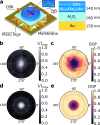Wavevector-resolved polarization entanglement from radiative cascades
- PMID: 40617830
- PMCID: PMC12228742
- DOI: 10.1038/s41467-025-61460-3
Wavevector-resolved polarization entanglement from radiative cascades
Abstract
The generation of entangled photons from radiative cascades has enabled milestone experiments in quantum information science with several applications in photonic quantum technologies. Significant efforts are being devoted to pushing the performances of near-deterministic entangled-photon sources based on single quantum emitters often embedded in photonic cavities, so to boost the flux of photon pairs. The general postulate is that the emitter generates photons in a nearly maximally entangled state of polarization, ready for application purposes. Here, we demonstrate that this assumption is unjustified. We show that in radiative cascades there exists an interplay between photon polarization and emission wavevector, which can be further amplified by embedding the emitters in micro-cavities. We discuss how the polarization entanglement of photon pairs from a biexciton-exciton cascade in quantum dots strongly depends on their propagation wavevector and we even observe entanglement vanishing for large emission angles. Our experimental results, backed by theoretical modeling, yield a brand-new understanding of cascaded emission for various quantum emitters. In addition, our model provides quantitative guidelines for designing optical microcavities that retain both a high degree of entanglement and collection efficiency, moving the community one step further towards an ideal source of entangled photons for quantum technologies.
© 2025. The Author(s).
Conflict of interest statement
Competing interests: The authors declare no competing interests.
Figures




References
-
- Freedman, S. J. & Clauser, J. F. Experimental test of local hidden-variable theories. Phys. Rev. Lett.28, 938 (1972).
-
- Aspect, A., Grangier, P. & Roger, G. Experimental tests of realistic local theories via Bell’s theorem. Phys. Rev. Lett.47, 460 (1981).
-
- Benson, O., Santori, C., Pelton, M. & Yamamoto, Y. Regulated and entangled photons from a single quantum dot. Phys. Rev. Lett.84, 2513 (2000). - PubMed
-
- Akopian, N. et al. Entangled photon pairs from semiconductor quantum dots. Phys. Rev. Lett.96, 130501 (2006). - PubMed
-
- Yin, C. et al. Bright-exciton fine-structure splittings in single perovskite nanocrystals. Phys. Rev. Lett.119, 026401 (2017). - PubMed
Grants and funding
LinkOut - more resources
Full Text Sources

